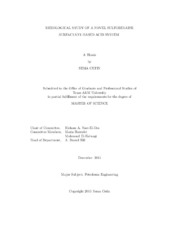| dc.description.abstract | Acid stimulation is a widely used well treatment technique applied to enhance oil production by creating conductive channels through the formation, resulting an improved flow property. Viscoelastic surfactant (VES)-based acids have been employed
for acidizing jobs due to their ability to build up sufficient viscosity for acid diversion and fluid loss reduction, and to break into low viscosity after the treatment is completed. This work studied rheological properties of a new zwitterionic viscoelastic surfactant-based stimulation fluid. Impacts of many variables on the rheological characteristics of the VES-based live and spent acids were examined.
Rheological experiments were conducted using a high pressure/high temperature (HPHT) viscometer. Viscosity measurements were performed between the temperatures of 78 to 350°F and shear rates of 10 to 935 s^-1 at 300 psi. Examined acid additives included: corrosion inhibitor, formic acid, methanol, demulsifier, H2S scavenger, iron control agents, and mutual solvent. As a contaminant, the effect of Fe(III) was investigated. In addition, the impacts of surfactant concentration, salt type and salt concentration on the viscosity of the VES-based acid systems were tested.
Experimental results indicated that the new VES-based acid system exhibits a sufficient viscosity for acid diversion at temperatures up to 270°F. Contrary to spent acid blends, VES did not build up high viscosity in live acid. Apparent viscosity of the spent acid showed a strong relation with surfactant concentration, salt type and salt concentration. Corrosion inhibitor concentration above 0.5 vol% caused a notable loss in the viscosity as the temperature increased gradually. Dependency on methanol was strong enough that it resulted in a decline of the apparent viscosity of both live and spent acid solutions. Iron control agents (citric acid and EDTA) did not alter the viscous behavior notably. H2S scavenger showed a similar effect as iron control agents, while demulsifier and mutual solvent caused a reduction in the apparent viscosity. Fe(III) contamination caused fluctuations in the live acid viscosity due to generated VES-iron complex. In spent condition, this complex caused phase separation that resulted in loss of viscosity.
This study showed that the new VES-based acid has the ability to build and maintain sufficient viscosity at higher temperatures than the currently used VES types. The acid system yielded higher tolerance to corrosion inhibitor than many other VES-based acids, and showed compatibility with a wide range of salt types. On the basis of the results obtained, optimum conditions to achieve the desired rheological profile for a successful well stimulation operation are presented. | en |


